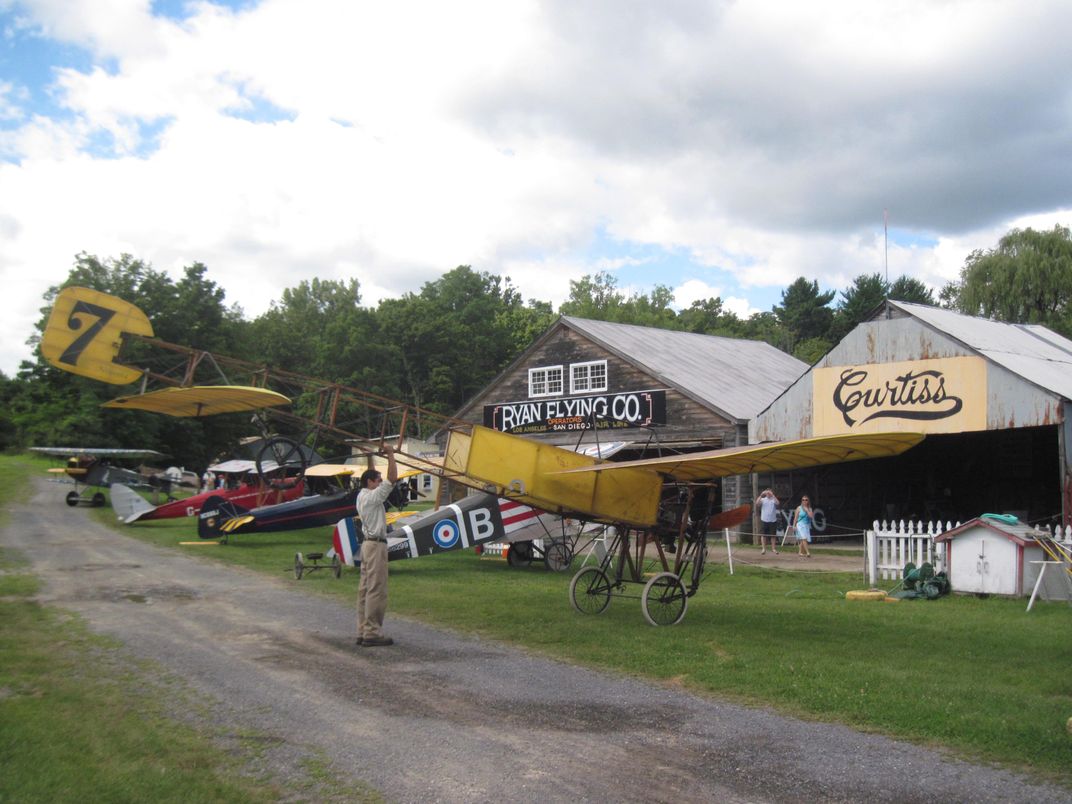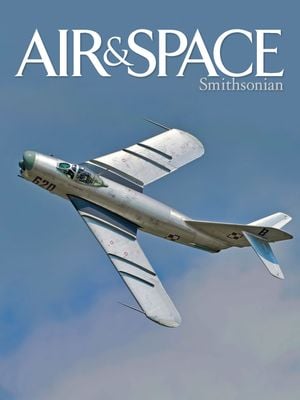Summer Days at the Aerodrome
A 1961 road trip to Rhinebeck, New York.
:focal(1592x682:1593x683)/https://tf-cmsv2-smithsonianmag-media.s3.amazonaws.com/filer/a0/e2/a0e25ffb-d8e0-42e3-9f99-e6f0f643498f/17a_on2018_img_7377_live.jpg)
When I was growing up in Akron, Ohio, my family would take a camping trip each summer. None of them stands out in my memory more than the one from 1961, when I was 16. My mom and dad piled my two sisters and two brothers into our 1957 Chevy Nomad station wagon and headed east. Our only firm destination was to arrive at the Willow Grove Naval Air Station outside of Philadelphia by the last week of July, when the Academy of Model Aeronautics was holding its annual meet there.
We’d planned to camp somewhere on the Hudson River and catch a train down to New York City. Before we left, Dad bought a Sunday edition of the New York Times to scope out any deals or coupons. In the travel section was an article about this guy Cole Palen who had purchased some World War I airplanes and had set up shop near Rhinebeck, New York. Instant itinerary change! We found a campsite near Hyde Park, just south of Rhinebeck, and the next day, a Thursday, we set out to find the Aerodrome. When we passed a mailbox mounted on a three-blade propeller, we knew we had arrived.
We barely had time to introduce ourselves before we were put to work getting the place ready for Sunday’s big show. The airstrip had a sharply banking layout, with both ends rising from a low spot in the center. The various hangars and sheds were all of rickety construction and looked as though they were on the verge of collapse. But the only thing that mattered to me was that they were full of airplanes and airplane parts.
Palen, the founder of the Old Rhinebeck Aerodrome, was supporting his enterprise by renting out some of his aircraft for flying shows and other events. I recall that Cole—as he invited me to call him—had displayed several of his aircraft at Wright-Patterson Air Force Base and had just received them back…disassembled. He and his crew were frantically trying to put them together for the airshow on Sunday. Dad and I, both being model builders, were put to work doping fabric patches on some puncture wounds in the skin of a 1930s Aeronca C-3, one of the more modern aircraft in the group.
Once we had finished, Cole announced that the C-3 had to be moved from the far side of the field to the flight line. He turned to me, a 16-year-old with no pilot’s license, and said “Jump in!” I obeyed. “Here’s the throttle,” he said. “There are no brakes.” He told me where to park his airplane and then walked over to spin the prop as though this was not the most exciting event in the history of the world. I taxied the C-3 across the field and walked on air for the rest of the day.

Our next project was reassembling a Fokker D.VII. It was minus wings and tail feathers. Cole tied a rope to the tail skid and we all pulled the Fokker over on its nose. That gave us easy access to the lower wing position. Several of us picked up the lower wing—it was impossibly heavy—and held it in place while my younger brother Phil popped in the mounting bolts. It took a few more of us to hold the upper wing in place while the struts were connected.
With the wings mounted, we added the tail feathers and finished bolting everything in place. Cole turned to me and handed me a bucket and a big funnel and asked me to fill the Fokker’s radiator. When I asked where I could get water, he pointed to a nearby frog pond. Pushing the algae and weeds out of the way, I filled the five-gallon bucket. Then it was back to the Fokker and up through the struts to position the funnel. I climbed back through the struts and picked up the water bucket. Only as I was pouring the five-gallon bucket of water I’d wrestled from the pond did I discover that the radiator held only three gallons.
To my utter surprise, Cole had me get in the big Fokker’s cockpit where he carefully explained what I had to do. The magneto switch was a wire with a washer tied to the end. To turn the mag off, you hung the washer on a hook on a metal longeron, shorting it out. To turn the mag on, you hung the washer on the wooden instrument panel.
Cole had his own method of firing up the straight six-cylinder Mercedes engine. On the back of the engine was a lever. Push it one way and you got half compression, push it the other way and you got full compression. Setting the lever to half compression and the mag off, he pulled the prop through while I gave it a couple of shots of prime.
The big Mercedes backfired, with the prop turning backwards. It hit the next compression cycle on the next cylinder, backfired again, and started running in the proper direction. At that point, I set the compression lever to full. I sat back in the cockpit enjoying the breeze from that big prop, closing my eyes and imagining myself as the Red Baron.
In one of those ramshackle hangars was the SPAD XIII. We placed a two-wheeled cart under the tail skid and dragged it out into the sun. My first job was to deal with the fuel situation. This SPAD had a tank in the upper wing and a belly tank. The fuel drained from the upper tank to the carburetor with any excess flowing into the belly tank. Most of the documentation I’ve read in the subsequent years states that the SPAD had an engine-driven pump to transfer the fuel back to the top tank. This one had a hand-operated wobble pump to do the pumping. Imagine the poor pilot, dealing with the stick, throttle and have to crank that wobble pump up and down too!
Cole then asked me if I minded washing down the airplane. My immediate response was to grab a bucket (pond water again) and a sponge. While I was washing it, I discovered that the insignia had been painted on with water-based paint. The damage wasn’t obvious. I decided I wouldn’t mention it to Cole.
Our next task was to haul a Nieuport over to the edge of the strip. The Nieuport had a big rotary engine. To start it up, Cole first tied it to a small tractor he used around the field. The engine had two speeds, on and off, so it was necessary to tether it to the tractor while being started. Dad got to sit in the cockpit. After much priming and prop pulling, the big rotary started up with a lot of smoke but (luckily) no fire.
Show day dawned clear and dry. Two things stood out about that day. The first was the Keystone Kops routine with the villains and heroes chasing up and down the flight line in antique cars, one driven by my dad.
The other was pilot Dave Fox flying the Alexander Eaglerock. He would take off and climb to altitude. While crossing the field, he would throw out a roll of toilet paper. As it fell, it would unroll like a streamer. Dave would cut the paper with the airplane’s propeller as many times as he could before running out of altitude.
We proceeded on to the Academy of Model Aeronautics meet after that, but nothing that happened there could compare with those days spent at the Aerodrome. Dad, Cole Palen, and Dave Fox have all passed, but the Old Rhinebeck Aerodrome continues to welcome aviation buffs from around the world. In the almost 60 years since my family spent those days there, I’ve never had reason to disagree with my 16-year-old self, who had the time of his life.
